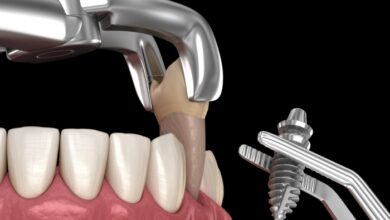How TMJ Affects Your Smile and What You Can Do About It

Temporomandibular joint (TMJ) disorders can impact oral health and overall well-being. Although primarily associated with jaw discomfort, TMJ issues can also affect the appearance and alignment of teeth, altering a smile. Understanding how this disorder impacts dental health and the available management strategies can help individuals make informed decisions about their care.
What is TMJ?
The temporomandibular joint (TMJ) connects the lower jaw to the skull, acting as a hinge that facilitates movement when speaking, chewing, or yawning. TMJ disorders arise when the joint is dysfunctional due to various factors, such as bruxism, injury, or genetic predisposition. This dysfunction can cause pain, limited jaw mobility, and other related symptoms.
How Does TMJ Affect Teeth Alignment?
Misalignment of the teeth can often accompany TMJ issues. When the jaw joint doesn’t function properly, it may strain surrounding muscles, leading to uneven pressure on the teeth. With time, this imbalance can shift teeth out of their natural positions or contribute to wear and tear. The resulting changes might alter your smile’s symmetry and overall appearance.
How Does TMJ Affect Facial Muscles and Smile Aesthetics?
TMJ disorders affect not only the teeth but also the surrounding facial muscles that shape your smile. Muscle tightness or spasms caused by this dysfunction can cause asymmetry, making one side of the face appear more prominent. Tension in these muscles may also contribute to discomfort when smiling or speaking. These muscle stresses can subtly alter how your smile looks over time.
What Are the Common Signs of TMJ Dysfunction?
Identifying the symptoms of TMJ dysfunction early can help minimize its effects on your oral and overall health. Common signs include:
- Jaw pain or tenderness, particularly near the ears or along the jawline
- Clicking or popping when moving the jaw
- Difficulty chewing or pain during chewing
- Swelling in the jaw or face
- Locked jaw, either in an open or closed position
If you experience these symptoms frequently, it may be time to seek professional evaluation.
What Are Non-Invasive and At-Home Treatments for TMJ?
Several non-invasive approaches can help manage symptoms effectively. These include:
- Night Guards: Custom-fitted night guards can reduce the strain on your jaw by preventing teeth grinding and reducing muscle tension during sleep.
- Cold/Heat Therapy: Applying cold packs or warm compresses to the affected area may help alleviate pain and reduce inflammation.
- Stretching and Relaxation Exercises: Gentle jaw exercises designed to enhance mobility and release tension can be performed at home.
- Over-the-Counter Pain Relief: Non-prescription anti-inflammatory medications may help manage occasional discomfort.
While at-home methods can be helpful, persistent or severe symptoms should be brought to a dentist’s attention.
How Do Dentists Diagnose and Treat TMJ?
Dentists play a key role in diagnosing and managing TMJ disorders. Through a thorough evaluation, they assess your symptoms, jaw alignment, and dental history to pinpoint the root cause. Depending on your individual needs, treatment options may include customized night guards, physical therapy referrals, or even medication. For some complex cases, advanced procedures like bite adjustments or surgical consultations may be necessary.
Take Action for Your TMJ Health
If you’ve noticed signs of TMJ dysfunction, taking proactive steps can help protect your smile and your overall well-being. Reach out to your dental professional for an evaluation and personalized treatment plan. TMJ management not only supports your dental health, but it can also enhance the function of your jaw. For persistent symptoms, schedule a consultation with your dentist to explore tailored solutions for long-term relief.




